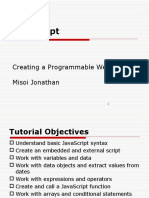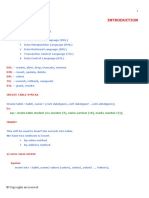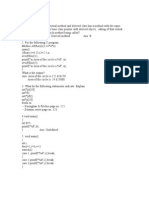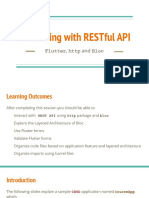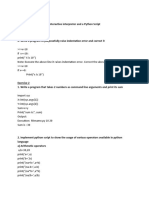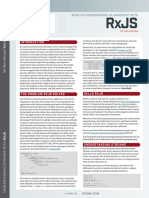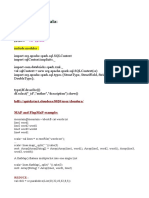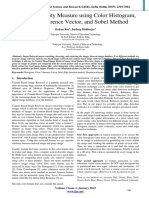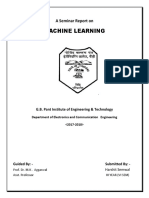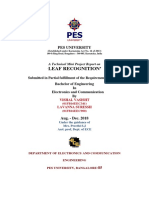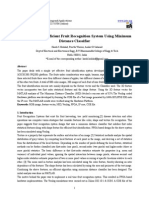Module 1 Topic-3-ML Framework
Uploaded by
pandharerohit2122Module 1 Topic-3-ML Framework
Uploaded by
pandharerohit2122ML Component Framework Training Data Model Loss Function Optimization Evaluation Summary
Machine Learning Techniques
ML Component Framework
Dr. Ashish Tendulkar
IIT Madras
Dr. Ashish Tendulkar Online Degree Program, IIT Madras
Machine Learning Techniques 1 / 28
ML Component Framework Training Data Model Loss Function Optimization Evaluation Summary
1 ML Component Framework
2 Training Data
3 Model
4 Loss Function
5 Optimization
6 Evaluation
7 Summary
Dr. Ashish Tendulkar Online Degree Program, IIT Madras
Machine Learning Techniques 2 / 28
ML Component Framework Training Data Model Loss Function Optimization Evaluation Summary
1 ML Component Framework
2 Training Data
3 Model
4 Loss Function
5 Optimization
6 Evaluation
7 Summary
Dr. Ashish Tendulkar Online Degree Program, IIT Madras
Machine Learning Techniques 3 / 28
ML Component Framework Training Data Model Loss Function Optimization Evaluation Summary
Machine Learning Process
Loss Label
Loss
TP vs FP rate at
a decision
threshold
w
Predicted Label
TP vs FP rate at
Metric
START HERE another decision
threshold
Negative
Starting Gradient Evaluation
Point
Final
Point
Loss
Model
w
Optimization Inference
Data
Training
Dr. Ashish Tendulkar Online Degree Program, IIT Madras
Machine Learning Techniques 4 / 28
ML Component Framework Training Data Model Loss Function Optimization Evaluation Summary
ML Component Framework
• Training data
• Model
• Loss function
• Optimization procedure
• Evaluation criteria
Dr. Ashish Tendulkar Online Degree Program, IIT Madras
Machine Learning Techniques 5 / 28
ML Component Framework Training Data Model Loss Function Optimization Evaluation Summary
ML Component Framework
• Training data
• Model
• Loss function
• Optimization procedure
• Evaluation criteria
Dr. Ashish Tendulkar Online Degree Program, IIT Madras
Machine Learning Techniques 5 / 28
ML Component Framework Training Data Model Loss Function Optimization Evaluation Summary
ML Component Framework
• Training data
• Model
• Loss function
• Optimization procedure
• Evaluation criteria
Dr. Ashish Tendulkar Online Degree Program, IIT Madras
Machine Learning Techniques 5 / 28
ML Component Framework Training Data Model Loss Function Optimization Evaluation Summary
ML Component Framework
• Training data
• Model
• Loss function
• Optimization procedure
• Evaluation criteria
Dr. Ashish Tendulkar Online Degree Program, IIT Madras
Machine Learning Techniques 5 / 28
ML Component Framework Training Data Model Loss Function Optimization Evaluation Summary
ML Component Framework
• Training data
• Model
• Loss function
• Optimization procedure
• Evaluation criteria
Dr. Ashish Tendulkar Online Degree Program, IIT Madras
Machine Learning Techniques 5 / 28
ML Component Framework Training Data Model Loss Function Optimization Evaluation Summary
ML Component Framework
• Training data
• Model
• Loss function
• Optimization procedure
• Evaluation criteria
Dr. Ashish Tendulkar Online Degree Program, IIT Madras
Machine Learning Techniques 5 / 28
ML Component Framework Training Data Model Loss Function Optimization Evaluation Summary
1 ML Component Framework
2 Training Data
3 Model
4 Loss Function
5 Optimization
6 Evaluation
7 Summary
Dr. Ashish Tendulkar Online Degree Program, IIT Madras
Machine Learning Techniques 6 / 28
ML Component Framework Training Data Model Loss Function Optimization Evaluation Summary
Training Data
• No data, no ML.
• In supervised learning, training data consists of input and
output pairs.
• Each input is represented by a bunch of numbers called
features or attributes.
• Apply certain transformations to convert input into a bunch of
numbers.
Dr. Ashish Tendulkar Online Degree Program, IIT Madras
Machine Learning Techniques 7 / 28
ML Component Framework Training Data Model Loss Function Optimization Evaluation Summary
Training Data
• No data, no ML.
• In supervised learning, training data consists of input and
output pairs.
• Each input is represented by a bunch of numbers called
features or attributes.
• Apply certain transformations to convert input into a bunch of
numbers.
Dr. Ashish Tendulkar Online Degree Program, IIT Madras
Machine Learning Techniques 7 / 28
ML Component Framework Training Data Model Loss Function Optimization Evaluation Summary
Training Data
• No data, no ML.
• In supervised learning, training data consists of input and
output pairs.
• Each input is represented by a bunch of numbers called
features or attributes.
• Apply certain transformations to convert input into a bunch of
numbers.
Dr. Ashish Tendulkar Online Degree Program, IIT Madras
Machine Learning Techniques 7 / 28
ML Component Framework Training Data Model Loss Function Optimization Evaluation Summary
Training Data
• No data, no ML.
• In supervised learning, training data consists of input and
output pairs.
• Each input is represented by a bunch of numbers called
features or attributes.
• Apply certain transformations to convert input into a bunch of
numbers.
Dr. Ashish Tendulkar Online Degree Program, IIT Madras
Machine Learning Techniques 7 / 28
ML Component Framework Training Data Model Loss Function Optimization Evaluation Summary
Training Data
• No data, no ML.
• In supervised learning, training data consists of input and
output pairs.
• Each input is represented by a bunch of numbers called
features or attributes.
• Apply certain transformations to convert input into a bunch of
numbers.
Dr. Ashish Tendulkar Online Degree Program, IIT Madras
Machine Learning Techniques 7 / 28
ML Component Framework Training Data Model Loss Function Optimization Evaluation Summary
Training Data
For example,
• Input may be an image or a piece of text.
• Certain pre-processing steps or transformations have to be
applied to obtain feature representation for such input data.
Dr. Ashish Tendulkar Online Degree Program, IIT Madras
Machine Learning Techniques 8 / 28
ML Component Framework Training Data Model Loss Function Optimization Evaluation Summary
Training Data
For example,
• Input may be an image or a piece of text.
• Certain pre-processing steps or transformations have to be
applied to obtain feature representation for such input data.
Dr. Ashish Tendulkar Online Degree Program, IIT Madras
Machine Learning Techniques 8 / 28
ML Component Framework Training Data Model Loss Function Optimization Evaluation Summary
Training Data
For example,
• Input may be an image or a piece of text.
• Certain pre-processing steps or transformations have to be
applied to obtain feature representation for such input data.
Dr. Ashish Tendulkar Online Degree Program, IIT Madras
Machine Learning Techniques 8 / 28
ML Component Framework Training Data Model Loss Function Optimization Evaluation Summary
Training Data
• Features: are provided by the domain experts.
• For example, while predicting price of a house:
• The expert would tell us which features are most important in
determining the price.
• The expert would also provide us with a dataset of houses with
their features and prices (which is what we are interested in
predicting.)
• Output: a real number or a discrete value from a predefined
set.
Dr. Ashish Tendulkar Online Degree Program, IIT Madras
Machine Learning Techniques 9 / 28
ML Component Framework Training Data Model Loss Function Optimization Evaluation Summary
Training Data
• Features: are provided by the domain experts.
• For example, while predicting price of a house:
• The expert would tell us which features are most important in
determining the price.
• The expert would also provide us with a dataset of houses with
their features and prices (which is what we are interested in
predicting.)
• Output: a real number or a discrete value from a predefined
set.
Dr. Ashish Tendulkar Online Degree Program, IIT Madras
Machine Learning Techniques 9 / 28
ML Component Framework Training Data Model Loss Function Optimization Evaluation Summary
Training Data
• Features: are provided by the domain experts.
• For example, while predicting price of a house:
• The expert would tell us which features are most important in
determining the price.
• The expert would also provide us with a dataset of houses with
their features and prices (which is what we are interested in
predicting.)
• Output: a real number or a discrete value from a predefined
set.
Dr. Ashish Tendulkar Online Degree Program, IIT Madras
Machine Learning Techniques 9 / 28
ML Component Framework Training Data Model Loss Function Optimization Evaluation Summary
Training Data
• Features: are provided by the domain experts.
• For example, while predicting price of a house:
• The expert would tell us which features are most important in
determining the price.
• The expert would also provide us with a dataset of houses with
their features and prices (which is what we are interested in
predicting.)
• Output: a real number or a discrete value from a predefined
set.
Dr. Ashish Tendulkar Online Degree Program, IIT Madras
Machine Learning Techniques 9 / 28
ML Component Framework Training Data Model Loss Function Optimization Evaluation Summary
Training Data
• Features: are provided by the domain experts.
• For example, while predicting price of a house:
• The expert would tell us which features are most important in
determining the price.
• The expert would also provide us with a dataset of houses with
their features and prices (which is what we are interested in
predicting.)
• Output: a real number or a discrete value from a predefined
set.
Dr. Ashish Tendulkar Online Degree Program, IIT Madras
Machine Learning Techniques 9 / 28
ML Component Framework Training Data Model Loss Function Optimization Evaluation Summary
Training Data
• Features: are provided by the domain experts.
• For example, while predicting price of a house:
• The expert would tell us which features are most important in
determining the price.
• The expert would also provide us with a dataset of houses with
their features and prices (which is what we are interested in
predicting.)
• Output: a real number or a discrete value from a predefined
set.
Dr. Ashish Tendulkar Online Degree Program, IIT Madras
Machine Learning Techniques 9 / 28
ML Component Framework Training Data Model Loss Function Optimization Evaluation Summary
Training Data
Example of a real valued label:
• The housing price prediction problem.
• Output label is price, a real number.
Dr. Ashish Tendulkar Online Degree Program, IIT Madras
Machine Learning Techniques 10 / 28
ML Component Framework Training Data Model Loss Function Optimization Evaluation Summary
Training Data
Example of a real valued label:
• The housing price prediction problem.
• Output label is price, a real number.
Dr. Ashish Tendulkar Online Degree Program, IIT Madras
Machine Learning Techniques 10 / 28
ML Component Framework Training Data Model Loss Function Optimization Evaluation Summary
Training Data
Example of a real valued label:
• The housing price prediction problem.
• Output label is price, a real number.
Dr. Ashish Tendulkar Online Degree Program, IIT Madras
Machine Learning Techniques 10 / 28
ML Component Framework Training Data Model Loss Function Optimization Evaluation Summary
Training Data
Examples of a discrete valued label:
• The handwritten digit prediction problem. 10 different values
as class labels - digit 0 to 9.
• Loan sanctioning. Binary labels - yes or no corresponding to
application being sanctioned or rejected.
Dr. Ashish Tendulkar Online Degree Program, IIT Madras
Machine Learning Techniques 11 / 28
ML Component Framework Training Data Model Loss Function Optimization Evaluation Summary
Training Data
Examples of a discrete valued label:
• The handwritten digit prediction problem. 10 different values
as class labels - digit 0 to 9.
• Loan sanctioning. Binary labels - yes or no corresponding to
application being sanctioned or rejected.
Dr. Ashish Tendulkar Online Degree Program, IIT Madras
Machine Learning Techniques 11 / 28
ML Component Framework Training Data Model Loss Function Optimization Evaluation Summary
Training Data
Examples of a discrete valued label:
• The handwritten digit prediction problem. 10 different values
as class labels - digit 0 to 9.
• Loan sanctioning. Binary labels - yes or no corresponding to
application being sanctioned or rejected.
Dr. Ashish Tendulkar Online Degree Program, IIT Madras
Machine Learning Techniques 11 / 28
ML Component Framework Training Data Model Loss Function Optimization Evaluation Summary
Training Data
• Once we have obtained training data, we get an idea about
input and output, which helps us in defining suitable ML
problems and choosing appropriate components like model,
loss and optimization procedure for training.
Dr. Ashish Tendulkar Online Degree Program, IIT Madras
Machine Learning Techniques 12 / 28
ML Component Framework Training Data Model Loss Function Optimization Evaluation Summary
1 ML Component Framework
2 Training Data
3 Model
4 Loss Function
5 Optimization
6 Evaluation
7 Summary
Dr. Ashish Tendulkar Online Degree Program, IIT Madras
Machine Learning Techniques 13 / 28
ML Component Framework Training Data Model Loss Function Optimization Evaluation Summary
Model
• Model provides a mathematical form of mapping between
input and output.
• The input is represented with a bunch of features and output
can be a real number or a discrete value from some finite set.
Dr. Ashish Tendulkar Online Degree Program, IIT Madras
Machine Learning Techniques 14 / 28
ML Component Framework Training Data Model Loss Function Optimization Evaluation Summary
Model
• Model provides a mathematical form of mapping between
input and output.
• The input is represented with a bunch of features and output
can be a real number or a discrete value from some finite set.
Dr. Ashish Tendulkar Online Degree Program, IIT Madras
Machine Learning Techniques 14 / 28
ML Component Framework Training Data Model Loss Function Optimization Evaluation Summary
Model
• Model provides a mathematical form of mapping between
input and output.
• The input is represented with a bunch of features and output
can be a real number or a discrete value from some finite set.
Dr. Ashish Tendulkar Online Degree Program, IIT Madras
Machine Learning Techniques 14 / 28
ML Component Framework Training Data Model Loss Function Optimization Evaluation Summary
Model
Example of a linear model :
• Output = weight0 + weight1 · feature1 + weight2 · feature2 +
· · · + weightm · featurem
• The key problem here is to estimate values of weights.
• All weights together form an entity called weight vector.
• We estimate the weight vector by training the model on the
training data.
• The ideal weights are the ones that when used in the model,
produce output that is close to the actual output for all
training data points.
Dr. Ashish Tendulkar Online Degree Program, IIT Madras
Machine Learning Techniques 15 / 28
ML Component Framework Training Data Model Loss Function Optimization Evaluation Summary
Model
Example of a linear model :
• Output = weight0 + weight1 · feature1 + weight2 · feature2 +
· · · + weightm · featurem
• The key problem here is to estimate values of weights.
• All weights together form an entity called weight vector.
• We estimate the weight vector by training the model on the
training data.
• The ideal weights are the ones that when used in the model,
produce output that is close to the actual output for all
training data points.
Dr. Ashish Tendulkar Online Degree Program, IIT Madras
Machine Learning Techniques 15 / 28
ML Component Framework Training Data Model Loss Function Optimization Evaluation Summary
Model
Example of a linear model :
• Output = weight0 + weight1 · feature1 + weight2 · feature2 +
· · · + weightm · featurem
• The key problem here is to estimate values of weights.
• All weights together form an entity called weight vector.
• We estimate the weight vector by training the model on the
training data.
• The ideal weights are the ones that when used in the model,
produce output that is close to the actual output for all
training data points.
Dr. Ashish Tendulkar Online Degree Program, IIT Madras
Machine Learning Techniques 15 / 28
ML Component Framework Training Data Model Loss Function Optimization Evaluation Summary
Model
Example of a linear model :
• Output = weight0 + weight1 · feature1 + weight2 · feature2 +
· · · + weightm · featurem
• The key problem here is to estimate values of weights.
• All weights together form an entity called weight vector.
• We estimate the weight vector by training the model on the
training data.
• The ideal weights are the ones that when used in the model,
produce output that is close to the actual output for all
training data points.
Dr. Ashish Tendulkar Online Degree Program, IIT Madras
Machine Learning Techniques 15 / 28
ML Component Framework Training Data Model Loss Function Optimization Evaluation Summary
Model
Example of a linear model :
• Output = weight0 + weight1 · feature1 + weight2 · feature2 +
· · · + weightm · featurem
• The key problem here is to estimate values of weights.
• All weights together form an entity called weight vector.
• We estimate the weight vector by training the model on the
training data.
• The ideal weights are the ones that when used in the model,
produce output that is close to the actual output for all
training data points.
Dr. Ashish Tendulkar Online Degree Program, IIT Madras
Machine Learning Techniques 15 / 28
ML Component Framework Training Data Model Loss Function Optimization Evaluation Summary
Model
Example of a linear model :
• Output = weight0 + weight1 · feature1 + weight2 · feature2 +
· · · + weightm · featurem
• The key problem here is to estimate values of weights.
• All weights together form an entity called weight vector.
• We estimate the weight vector by training the model on the
training data.
• The ideal weights are the ones that when used in the model,
produce output that is close to the actual output for all
training data points.
Dr. Ashish Tendulkar Online Degree Program, IIT Madras
Machine Learning Techniques 15 / 28
ML Component Framework Training Data Model Loss Function Optimization Evaluation Summary
Model
• Depending on the nature of the output, we choose our model.
• When the output is a real number, we choose models of
regression - which are capable of producing a real valued
output.
• When the output is a discrete value, we choose models of
classification - which produce a discrete quantity as an output.
Dr. Ashish Tendulkar Online Degree Program, IIT Madras
Machine Learning Techniques 16 / 28
ML Component Framework Training Data Model Loss Function Optimization Evaluation Summary
Model
• Depending on the nature of the output, we choose our model.
• When the output is a real number, we choose models of
regression - which are capable of producing a real valued
output.
• When the output is a discrete value, we choose models of
classification - which produce a discrete quantity as an output.
Dr. Ashish Tendulkar Online Degree Program, IIT Madras
Machine Learning Techniques 16 / 28
ML Component Framework Training Data Model Loss Function Optimization Evaluation Summary
Model
• Depending on the nature of the output, we choose our model.
• When the output is a real number, we choose models of
regression - which are capable of producing a real valued
output.
• When the output is a discrete value, we choose models of
classification - which produce a discrete quantity as an output.
Dr. Ashish Tendulkar Online Degree Program, IIT Madras
Machine Learning Techniques 16 / 28
ML Component Framework Training Data Model Loss Function Optimization Evaluation Summary
1 ML Component Framework
2 Training Data
3 Model
4 Loss Function
5 Optimization
6 Evaluation
7 Summary
Dr. Ashish Tendulkar Online Degree Program, IIT Madras
Machine Learning Techniques 17 / 28
ML Component Framework Training Data Model Loss Function Optimization Evaluation Summary
Loss Function
• The key objective of training a model is to estimate the weight
vector and we need a principled way of doing that.
• We need a suitable method for measuring the difference
between predicted and actual output.
• Loss function provides that measure.
• Loss function is a function of weight vector - as we change the
weight vector, we obtain a new model, which will have
different a loss.
Dr. Ashish Tendulkar Online Degree Program, IIT Madras
Machine Learning Techniques 18 / 28
ML Component Framework Training Data Model Loss Function Optimization Evaluation Summary
Loss Function
• The key objective of training a model is to estimate the weight
vector and we need a principled way of doing that.
• We need a suitable method for measuring the difference
between predicted and actual output.
• Loss function provides that measure.
• Loss function is a function of weight vector - as we change the
weight vector, we obtain a new model, which will have
different a loss.
Dr. Ashish Tendulkar Online Degree Program, IIT Madras
Machine Learning Techniques 18 / 28
ML Component Framework Training Data Model Loss Function Optimization Evaluation Summary
Loss Function
• The key objective of training a model is to estimate the weight
vector and we need a principled way of doing that.
• We need a suitable method for measuring the difference
between predicted and actual output.
• Loss function provides that measure.
• Loss function is a function of weight vector - as we change the
weight vector, we obtain a new model, which will have
different a loss.
Dr. Ashish Tendulkar Online Degree Program, IIT Madras
Machine Learning Techniques 18 / 28
ML Component Framework Training Data Model Loss Function Optimization Evaluation Summary
Loss Function
• The key objective of training a model is to estimate the weight
vector and we need a principled way of doing that.
• We need a suitable method for measuring the difference
between predicted and actual output.
• Loss function provides that measure.
• Loss function is a function of weight vector - as we change the
weight vector, we obtain a new model, which will have
different a loss.
Dr. Ashish Tendulkar Online Degree Program, IIT Madras
Machine Learning Techniques 18 / 28
ML Component Framework Training Data Model Loss Function Optimization Evaluation Summary
Loss Function
• Denote loss with letter J.
• J : W −→ R
• J(W ) = Difference between actual and predicted output for
all training samples.
• In the following example model:
Output = weight0 + weight1 · feature1 + weight2 · feature2 +
· · · + weightm · featurem
• Everything except weight vector is fixed on the right side of
the equation- features are specified as part of the training
data, which is fixed and weights are variables.
• The weights can be changed to obtain a different result or
output.
Dr. Ashish Tendulkar Online Degree Program, IIT Madras
Machine Learning Techniques 19 / 28
ML Component Framework Training Data Model Loss Function Optimization Evaluation Summary
Loss Function
• Denote loss with letter J.
• J : W −→ R
• J(W ) = Difference between actual and predicted output for
all training samples.
• In the following example model:
Output = weight0 + weight1 · feature1 + weight2 · feature2 +
· · · + weightm · featurem
• Everything except weight vector is fixed on the right side of
the equation- features are specified as part of the training
data, which is fixed and weights are variables.
• The weights can be changed to obtain a different result or
output.
Dr. Ashish Tendulkar Online Degree Program, IIT Madras
Machine Learning Techniques 19 / 28
ML Component Framework Training Data Model Loss Function Optimization Evaluation Summary
Loss Function
• Denote loss with letter J.
• J : W −→ R
• J(W ) = Difference between actual and predicted output for
all training samples.
• In the following example model:
Output = weight0 + weight1 · feature1 + weight2 · feature2 +
· · · + weightm · featurem
• Everything except weight vector is fixed on the right side of
the equation- features are specified as part of the training
data, which is fixed and weights are variables.
• The weights can be changed to obtain a different result or
output.
Dr. Ashish Tendulkar Online Degree Program, IIT Madras
Machine Learning Techniques 19 / 28
ML Component Framework Training Data Model Loss Function Optimization Evaluation Summary
Loss Function
• Denote loss with letter J.
• J : W −→ R
• J(W ) = Difference between actual and predicted output for
all training samples.
• In the following example model:
Output = weight0 + weight1 · feature1 + weight2 · feature2 +
· · · + weightm · featurem
• Everything except weight vector is fixed on the right side of
the equation- features are specified as part of the training
data, which is fixed and weights are variables.
• The weights can be changed to obtain a different result or
output.
Dr. Ashish Tendulkar Online Degree Program, IIT Madras
Machine Learning Techniques 19 / 28
ML Component Framework Training Data Model Loss Function Optimization Evaluation Summary
Loss Function
• Denote loss with letter J.
• J : W −→ R
• J(W ) = Difference between actual and predicted output for
all training samples.
• In the following example model:
Output = weight0 + weight1 · feature1 + weight2 · feature2 +
· · · + weightm · featurem
• Everything except weight vector is fixed on the right side of
the equation- features are specified as part of the training
data, which is fixed and weights are variables.
• The weights can be changed to obtain a different result or
output.
Dr. Ashish Tendulkar Online Degree Program, IIT Madras
Machine Learning Techniques 19 / 28
ML Component Framework Training Data Model Loss Function Optimization Evaluation Summary
Loss Function
• Denote loss with letter J.
• J : W −→ R
• J(W ) = Difference between actual and predicted output for
all training samples.
• In the following example model:
Output = weight0 + weight1 · feature1 + weight2 · feature2 +
· · · + weightm · featurem
• Everything except weight vector is fixed on the right side of
the equation- features are specified as part of the training
data, which is fixed and weights are variables.
• The weights can be changed to obtain a different result or
output.
Dr. Ashish Tendulkar Online Degree Program, IIT Madras
Machine Learning Techniques 19 / 28
ML Component Framework Training Data Model Loss Function Optimization Evaluation Summary
Loss Function
• An example of loss function is squared loss function: It is
calculated as a sum of square of differences between the actual
and predicted values.
n
X
J(W ) = [predicted (i) − actual (i) ]2
i=1
• Above equation can be simplified to:
J(W ) = ni=1 [{weight0 + weight1 · feature1 (i) + weight2 ·
P
feature2 (i) + · · · + weightm · featurem (i) } − actual (i) ]2
Dr. Ashish Tendulkar Online Degree Program, IIT Madras
Machine Learning Techniques 20 / 28
ML Component Framework Training Data Model Loss Function Optimization Evaluation Summary
Loss Function
• An example of loss function is squared loss function: It is
calculated as a sum of square of differences between the actual
and predicted values.
n
X
J(W ) = [predicted (i) − actual (i) ]2
i=1
• Above equation can be simplified to:
J(W ) = ni=1 [{weight0 + weight1 · feature1 (i) + weight2 ·
P
feature2 (i) + · · · + weightm · featurem (i) } − actual (i) ]2
Dr. Ashish Tendulkar Online Degree Program, IIT Madras
Machine Learning Techniques 20 / 28
ML Component Framework Training Data Model Loss Function Optimization Evaluation Summary
Loss Function
• An example of loss function is squared loss function: It is
calculated as a sum of square of differences between the actual
and predicted values.
n
X
J(W ) = [predicted (i) − actual (i) ]2
i=1
• Above equation can be simplified to:
J(W ) = ni=1 [{weight0 + weight1 · feature1 (i) + weight2 ·
P
feature2 (i) + · · · + weightm · featurem (i) } − actual (i) ]2
Dr. Ashish Tendulkar Online Degree Program, IIT Madras
Machine Learning Techniques 20 / 28
ML Component Framework Training Data Model Loss Function Optimization Evaluation Summary
Loss Function
• Our job is to find the weight vector that results in the lowest
loss as per the defined loss function.
• How to estimate such a weight vector?
• Brute force search for the optimal weight vector, but that is
not at all efficient.
• What is the best way to estimate it?
• Well that’s what is the purpose of our next component:
optimization procedure.
Dr. Ashish Tendulkar Online Degree Program, IIT Madras
Machine Learning Techniques 21 / 28
ML Component Framework Training Data Model Loss Function Optimization Evaluation Summary
Loss Function
• Our job is to find the weight vector that results in the lowest
loss as per the defined loss function.
• How to estimate such a weight vector?
• Brute force search for the optimal weight vector, but that is
not at all efficient.
• What is the best way to estimate it?
• Well that’s what is the purpose of our next component:
optimization procedure.
Dr. Ashish Tendulkar Online Degree Program, IIT Madras
Machine Learning Techniques 21 / 28
ML Component Framework Training Data Model Loss Function Optimization Evaluation Summary
Loss Function
• Our job is to find the weight vector that results in the lowest
loss as per the defined loss function.
• How to estimate such a weight vector?
• Brute force search for the optimal weight vector, but that is
not at all efficient.
• What is the best way to estimate it?
• Well that’s what is the purpose of our next component:
optimization procedure.
Dr. Ashish Tendulkar Online Degree Program, IIT Madras
Machine Learning Techniques 21 / 28
ML Component Framework Training Data Model Loss Function Optimization Evaluation Summary
Loss Function
• Our job is to find the weight vector that results in the lowest
loss as per the defined loss function.
• How to estimate such a weight vector?
• Brute force search for the optimal weight vector, but that is
not at all efficient.
• What is the best way to estimate it?
• Well that’s what is the purpose of our next component:
optimization procedure.
Dr. Ashish Tendulkar Online Degree Program, IIT Madras
Machine Learning Techniques 21 / 28
ML Component Framework Training Data Model Loss Function Optimization Evaluation Summary
Loss Function
• Our job is to find the weight vector that results in the lowest
loss as per the defined loss function.
• How to estimate such a weight vector?
• Brute force search for the optimal weight vector, but that is
not at all efficient.
• What is the best way to estimate it?
• Well that’s what is the purpose of our next component:
optimization procedure.
Dr. Ashish Tendulkar Online Degree Program, IIT Madras
Machine Learning Techniques 21 / 28
ML Component Framework Training Data Model Loss Function Optimization Evaluation Summary
1 ML Component Framework
2 Training Data
3 Model
4 Loss Function
5 Optimization
6 Evaluation
7 Summary
Dr. Ashish Tendulkar Online Degree Program, IIT Madras
Machine Learning Techniques 22 / 28
ML Component Framework Training Data Model Loss Function Optimization Evaluation Summary
Finding Weight Vector
• Obtain a weight vector that minimizes the loss function.
• Formally,
W = argminW J(W )
• Applications of derivatives are typically in 12th calculus in the
context of such problems.
• Take a derivative of loss function w.r.t. the weight vector and
set it to 0.
d
J(W ) = 0
dW
• Solve this equation directly or with analytical methods to
obtain the optimal weight vector.
• The optimization procedure is a cornerstone of model training.
Dr. Ashish Tendulkar Online Degree Program, IIT Madras
Machine Learning Techniques 23 / 28
ML Component Framework Training Data Model Loss Function Optimization Evaluation Summary
Finding Weight Vector
• Obtain a weight vector that minimizes the loss function.
• Formally,
W = argminW J(W )
• Applications of derivatives are typically in 12th calculus in the
context of such problems.
• Take a derivative of loss function w.r.t. the weight vector and
set it to 0.
d
J(W ) = 0
dW
• Solve this equation directly or with analytical methods to
obtain the optimal weight vector.
• The optimization procedure is a cornerstone of model training.
Dr. Ashish Tendulkar Online Degree Program, IIT Madras
Machine Learning Techniques 23 / 28
ML Component Framework Training Data Model Loss Function Optimization Evaluation Summary
Finding Weight Vector
• Obtain a weight vector that minimizes the loss function.
• Formally,
W = argminW J(W )
• Applications of derivatives are typically in 12th calculus in the
context of such problems.
• Take a derivative of loss function w.r.t. the weight vector and
set it to 0.
d
J(W ) = 0
dW
• Solve this equation directly or with analytical methods to
obtain the optimal weight vector.
• The optimization procedure is a cornerstone of model training.
Dr. Ashish Tendulkar Online Degree Program, IIT Madras
Machine Learning Techniques 23 / 28
ML Component Framework Training Data Model Loss Function Optimization Evaluation Summary
Finding Weight Vector
• Obtain a weight vector that minimizes the loss function.
• Formally,
W = argminW J(W )
• Applications of derivatives are typically in 12th calculus in the
context of such problems.
• Take a derivative of loss function w.r.t. the weight vector and
set it to 0.
d
J(W ) = 0
dW
• Solve this equation directly or with analytical methods to
obtain the optimal weight vector.
• The optimization procedure is a cornerstone of model training.
Dr. Ashish Tendulkar Online Degree Program, IIT Madras
Machine Learning Techniques 23 / 28
ML Component Framework Training Data Model Loss Function Optimization Evaluation Summary
Finding Weight Vector
• Obtain a weight vector that minimizes the loss function.
• Formally,
W = argminW J(W )
• Applications of derivatives are typically in 12th calculus in the
context of such problems.
• Take a derivative of loss function w.r.t. the weight vector and
set it to 0.
d
J(W ) = 0
dW
• Solve this equation directly or with analytical methods to
obtain the optimal weight vector.
• The optimization procedure is a cornerstone of model training.
Dr. Ashish Tendulkar Online Degree Program, IIT Madras
Machine Learning Techniques 23 / 28
ML Component Framework Training Data Model Loss Function Optimization Evaluation Summary
Finding Weight Vector
• Obtain a weight vector that minimizes the loss function.
• Formally,
W = argminW J(W )
• Applications of derivatives are typically in 12th calculus in the
context of such problems.
• Take a derivative of loss function w.r.t. the weight vector and
set it to 0.
d
J(W ) = 0
dW
• Solve this equation directly or with analytical methods to
obtain the optimal weight vector.
• The optimization procedure is a cornerstone of model training.
Dr. Ashish Tendulkar Online Degree Program, IIT Madras
Machine Learning Techniques 23 / 28
ML Component Framework Training Data Model Loss Function Optimization Evaluation Summary
Finding Weight Vector
• Obtain a weight vector that minimizes the loss function.
• Formally,
W = argminW J(W )
• Applications of derivatives are typically in 12th calculus in the
context of such problems.
• Take a derivative of loss function w.r.t. the weight vector and
set it to 0.
d
J(W ) = 0
dW
• Solve this equation directly or with analytical methods to
obtain the optimal weight vector.
• The optimization procedure is a cornerstone of model training.
Dr. Ashish Tendulkar Online Degree Program, IIT Madras
Machine Learning Techniques 23 / 28
ML Component Framework Training Data Model Loss Function Optimization Evaluation Summary
1 ML Component Framework
2 Training Data
3 Model
4 Loss Function
5 Optimization
6 Evaluation
7 Summary
Dr. Ashish Tendulkar Online Degree Program, IIT Madras
Machine Learning Techniques 24 / 28
ML Component Framework Training Data Model Loss Function Optimization Evaluation Summary
Evaluation
After optimization:
• How to evaluate the model on unseen data?
• What metric to use?
• The evaluation metric changes as per the problem - different
metric for regression and classification problems.
Dr. Ashish Tendulkar Online Degree Program, IIT Madras
Machine Learning Techniques 25 / 28
ML Component Framework Training Data Model Loss Function Optimization Evaluation Summary
Evaluation
After optimization:
• How to evaluate the model on unseen data?
• What metric to use?
• The evaluation metric changes as per the problem - different
metric for regression and classification problems.
Dr. Ashish Tendulkar Online Degree Program, IIT Madras
Machine Learning Techniques 25 / 28
ML Component Framework Training Data Model Loss Function Optimization Evaluation Summary
Evaluation
After optimization:
• How to evaluate the model on unseen data?
• What metric to use?
• The evaluation metric changes as per the problem - different
metric for regression and classification problems.
Dr. Ashish Tendulkar Online Degree Program, IIT Madras
Machine Learning Techniques 25 / 28
ML Component Framework Training Data Model Loss Function Optimization Evaluation Summary
Evaluation
After optimization:
• How to evaluate the model on unseen data?
• What metric to use?
• The evaluation metric changes as per the problem - different
metric for regression and classification problems.
Dr. Ashish Tendulkar Online Degree Program, IIT Madras
Machine Learning Techniques 25 / 28
ML Component Framework Training Data Model Loss Function Optimization Evaluation Summary
Evaluation
• What if the model does not perform as per the expectation as
found via evaluation metric?
• Reiterate the ML pipeline.
• Try to add superior
• features
• models
• loss function
• optimization procedure
Dr. Ashish Tendulkar Online Degree Program, IIT Madras
Machine Learning Techniques 26 / 28
ML Component Framework Training Data Model Loss Function Optimization Evaluation Summary
Evaluation
• What if the model does not perform as per the expectation as
found via evaluation metric?
• Reiterate the ML pipeline.
• Try to add superior
• features
• models
• loss function
• optimization procedure
Dr. Ashish Tendulkar Online Degree Program, IIT Madras
Machine Learning Techniques 26 / 28
ML Component Framework Training Data Model Loss Function Optimization Evaluation Summary
Evaluation
• What if the model does not perform as per the expectation as
found via evaluation metric?
• Reiterate the ML pipeline.
• Try to add superior
• features
• models
• loss function
• optimization procedure
Dr. Ashish Tendulkar Online Degree Program, IIT Madras
Machine Learning Techniques 26 / 28
ML Component Framework Training Data Model Loss Function Optimization Evaluation Summary
1 ML Component Framework
2 Training Data
3 Model
4 Loss Function
5 Optimization
6 Evaluation
7 Summary
Dr. Ashish Tendulkar Online Degree Program, IIT Madras
Machine Learning Techniques 27 / 28
ML Component Framework Training Data Model Loss Function Optimization Evaluation Summary
Summary
Machine Learning Process
Loss Label
Loss
TP vs FP rate at
a decision
threshold
w
Predicted Label
TP vs FP rate at
Metric
START HERE another decision
threshold
Negative
Starting Gradient Evaluation
Point
Final
Point
Loss
Model
w
Optimization Inference
Data
Training
Dr. Ashish Tendulkar Online Degree Program, IIT Madras
Machine Learning Techniques 28 / 28
You might also like
- Top 100 Pyspark Functions For Data Engineers 1738131847No ratings yetTop 100 Pyspark Functions For Data Engineers 173813184730 pages
- Javascript: Creating A Programmable Web Page Misoi JonathanNo ratings yetJavascript: Creating A Programmable Web Page Misoi Jonathan63 pages
- 06 Adding Interactivity and Assets To Your Flutter AppNo ratings yet06 Adding Interactivity and Assets To Your Flutter App47 pages
- Introduction To Data Visualization With PythonNo ratings yetIntroduction To Data Visualization With Python47 pages
- RDBMS Concepts: © Tata Consultancy Services Ltd. July 7, 2018 1No ratings yetRDBMS Concepts: © Tata Consultancy Services Ltd. July 7, 2018 138 pages
- Data Science & Python Programming GuideNo ratings yetData Science & Python Programming Guide23 pages
- Lecture # 12 - Introduction To React JSNo ratings yetLecture # 12 - Introduction To React JS76 pages
- Deep Learning Techniques & ApplicationsNo ratings yetDeep Learning Techniques & Applications41 pages
- 05 NumPy - Arrays and Vectorized ComputationNo ratings yet05 NumPy - Arrays and Vectorized Computation47 pages
- Detection of Fake Images Using Metadata Analysis and Error Level AnalysisNo ratings yetDetection of Fake Images Using Metadata Analysis and Error Level Analysis28 pages
- Image Similarity Measure Using Color Histogram, Color Coherence Vector, and Sobel MethodNo ratings yetImage Similarity Measure Using Color Histogram, Color Coherence Vector, and Sobel Method6 pages
- Real Time Myanmar Traffic Sign Recognition System Using HOG and SVMNo ratings yetReal Time Myanmar Traffic Sign Recognition System Using HOG and SVM5 pages
- Handwriting Enhancement Recognition-Based and Recognition-Independent Approaches For On-Device Online Handwritten Text AlignmentNo ratings yetHandwriting Enhancement Recognition-Based and Recognition-Independent Approaches For On-Device Online Handwritten Text Alignment15 pages
- GIS Based Network Analysis of Public Transport Accessibility in Temeke Municipality, Tanzania.No ratings yetGIS Based Network Analysis of Public Transport Accessibility in Temeke Municipality, Tanzania.49 pages
- An FPGA Based Efficient Fruit Recognition System Using MinimumNo ratings yetAn FPGA Based Efficient Fruit Recognition System Using Minimum11 pages
- Over The Air Deep Learning Based Radio Signal ClassificationNo ratings yetOver The Air Deep Learning Based Radio Signal Classification12 pages
- Symbol - Recognition - Current - Advances - and - Perspective in AINo ratings yetSymbol - Recognition - Current - Advances - and - Perspective in AI26 pages
- Cancerdiscover: An Integrative Pipeline For Cancer Biomarker and Cancer Class Prediction From High-Throughput Sequencing DataNo ratings yetCancerdiscover: An Integrative Pipeline For Cancer Biomarker and Cancer Class Prediction From High-Throughput Sequencing Data9 pages
- Shigeaki Sakurai-Theory and Applications For Advanced Text Mining-InTech (2012)No ratings yetShigeaki Sakurai-Theory and Applications For Advanced Text Mining-InTech (2012)226 pages
- yO5PJdPFShyuTyXTxbocww - Feature Engineering - Course SummaryNo ratings yetyO5PJdPFShyuTyXTxbocww - Feature Engineering - Course Summary6 pages
- Unit 2: Feature Extraction & Selection: Artificial Intelligence & Machine LearningNo ratings yetUnit 2: Feature Extraction & Selection: Artificial Intelligence & Machine Learning42 pages











